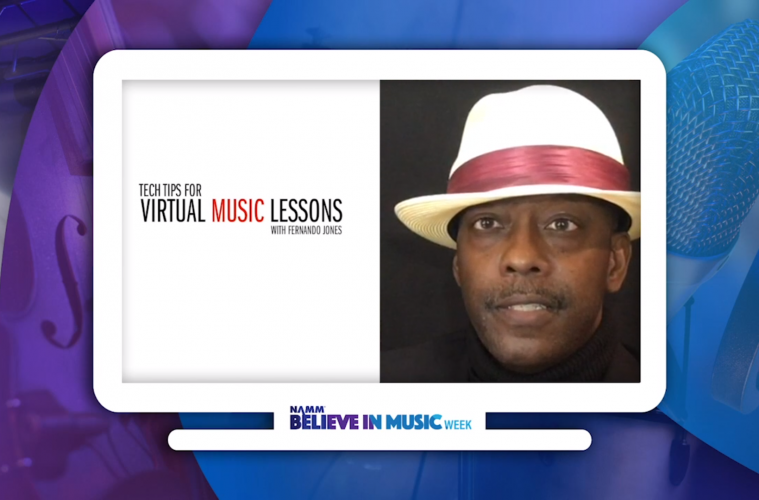In “Tech Tips for Virtual Music Lessons,” presenter Fernando Jones offered practical tips for beginners who are looking to start a virtual music lessons program. This session took place on Jan. 21, 2021, as part of NAMM’s Believe In Music Week.
Jones is the founder of Blues Kids of America and Blues Camp, Blues Ensemble director at Columbia College Chicago, and an international recording artist with a wealth of experience teaching virtual music lessons. During this session, Jones broke his virtual lesson tips into three categories: Technology, Presentation Prep and Production.
Here are some key points from his presentation:
- Technology
- When it comes to choosing a device for creating video content, a desktop equipped with a dedicated webcam should be your first choice, followed by a laptop or tablet. Avoid relying on a cell phone for video if you can.
- Make sure your internet connection is as stable as possible, particularly when it comes to live video. If possible, use a hardwired Ethernet connection instead of relying on Wi-Fi. A hardwired connection will be more stable than a wireless connection, which will prevent your video from appearing jittery, and it will be much less likely that the connection will drop.
- Presentation Prep
- You may want to choose a signature look or outfit for when you record your videos. (Jones gave the example of one of his favorite television personalities, Rachel Maddow, who almost always wears simple black blazers, which conveys consistency and a businesslike approach to being on camera. Similarly, when Mr. Rogers put on a sweater, you knew it was time for him to start the show.) Although you may be tempted to dress flashy in order to stand out, avoid wearing outfits that will distract the viewer and take away from your subject matter.
- According to Jones, “Your backdrop setting is equally as important as your face. It is a partner to your face and the information that you are delivering. So you don’t want to have a backdrop that will upstage what you are talking about.” Jones added, “You don’t want to be talking about major chords and minor chords, and your student is too busy reading the 12 posters that you have in the back. And when you ask them if they understand, they say ‘Oh, I see The Doors played the Fillmore East. What year was that?’”
- Jones weighed the pros and cons of three common video background choices. A plain white background makes the subject of the video “pop,” allowing for clearer, more detailed shots (for example, a white background would be a good choice for a teacher who is playing an instrument on camera). A green screen allows for more effective use of virtual backgrounds. And a plain black background creates what Jones calls “the Charlie Rose effect,” which adds a feel of seriousness and professionalism.
- Lighting is extremely important for capturing video. A common ring light positioned behind the camera is an easy lighting solution for most video applications, including virtual music lessons. If you don’t have a ring light, a typical table lamp placed behind the camera will suffice.
- Production
- You can build your own virtual lessons studio using your desktop or laptop computer, a webcam with a built-in mic (or a separate, dedicated mic), a set of speakers or monitors, and a pair of headphones or earbuds (which are important to use for music lessons and other video chat applications where the participants need to really focus in on the audio and avoid any feedback).
- Remember to make sure your camera is at eye level and that you focus on it when recording.
- For virtual music lessons or songwriting classes, you may want to use a DAW (digital audio workstation), teaching app or other software. If possible, all participants should use the same software. GarageBand is a common solution for Mac users, and there are other programs like Pro Tools that can be used for other platforms.
Click here for more of the Music & Sound Retailer’s CTV @ Believe In Music Week coverage.


